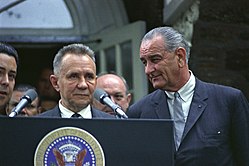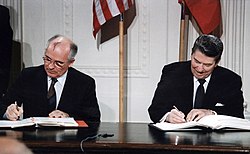List of Soviet Union–United States summits
Moscow Summit (1988) postage stamps, Spasskaya Tower and handshakeSoviet Union–United States summits were held from 1943 to 1991. The topics discussed at the summits between the president of the United States and either the general secretary or the premier of the Soviet Union ranged from fighting the Axis Powers during World War II to arms control between the two superpowers themselves during the Cold War .[ 1]
The "Big Three" Allied leaders (left to right) at the Yalta Conference , February 1945: Winston Churchill , Franklin D. Roosevelt and Joseph Stalin . Clement Attlee , Harry S. Truman and Joseph Stalin at the Potsdam Conference , July 1945.
Date
Place
Country
President of the United States
General Secretary or Premier of the Soviet Union
Notes
November 28–December 1, 1943
Tehran
Iran [ 2] Franklin D. Roosevelt
Joseph Stalin
Held at the Soviet Embassy in Tehran. Also in attendance Prime Minister Winston Churchill of the United Kingdom . Ended with the Western Allies committing themselves to open a second front against Nazi Germany through the planned amphibious invasion of Normandy . They also agreed to provide full support to the Yugoslav Partisans over the Chetniks . In return, the Soviet Union agreed to support the creation of the United Nations after the war and eventually enter the Allied campaign against Japan . They also agreed to divide Germany into occupation zones and recognize Iran as an independent state after the war.
February 4–11, 1945
Yalta
Soviet Union [ 2] Held at the Livadia Palace . Also in attendance Prime Minister Winston Churchill of the United Kingdom. First visit by a United States President to the Soviet Union.[ 3] Berlin into American, British, French, and Soviet zones of occupation. Imposed reparations , denazification , and demilitarization on postwar Germany. Obtained Western recognition of Soviet puppet government in Poland. Obtained Soviet commitment to enter the United Nations in exchange for allowing all 16 Soviet Socialist Republics membership. Mandated trials for Nazi war criminals after the war.
July 17–August 2, 1945
Potsdam
Allied-occupied Germany [ 4] Harry S. Truman
Held at the Cecilienhof Palace . Also in attendance Prime Ministers Winston Churchill and Clement Attlee of the United Kingdom, with a switch caused by the Labour Party 's victory in the 1945 general election . Planned for the postwar order and terms of peace treaties after World War II. Mandated complete abolition of Nazi political institutions and laws in Germany, initiated democratization reforms, and planned dismantlement of industry . Set the Oder-Neisse line as the western border of Poland and Germany. Allowed expulsions of ethnic Germans from Eastern Europe . Created conditions which allowed the Soviet Union to establish satellite states in Eastern Europe after the war.
Cold War
Nikita Khrushchev meeting John F. Kennedy at the Vienna Summit , June 1961
Alexei Kosygin with U.S. President Lyndon B. Johnson at the summitLeonid Brezhnev meets with Richard Nixon during the Soviet leader's trip to the U.S. in June 1973Jimmy Carter and Leonid Brezhnev signing SALT II Treaty , June 18, 1979, in Vienna
Date
Place
Country
President of the United States
General Secretary or Premier of the Soviet Union
Notes
June 23 and 25, 1967
Glassboro
United States [ 6] Lyndon B. Johnson
Alexei Kosygin
Held at Hollybush Mansion in Glassboro State College . Convened due to the intensifying Vietnam War and the Six-Day War . Failed to reach concrete agreements but resulted in improved Soviet Union–United States relations and the period of détente
May 22–30, 1972
Moscow
Soviet Union [ 9] Richard Nixon
Leonid Brezhnev and Alexei Kosygin
First visit by an American head of state to the Soviet Union since World War II. Held at the Kremlin Palace . Signing of the Anti-Ballistic Missile (ABM) Treaty , the first Strategic Arms Limitation Treaty (SALT I), and the U.S.–Soviet Incidents at Sea Agreement . The treaties limited strategic nuclear weapons and specifically anti-ballistic missiles
June 18–25, 1973
Washington, D.C.
United States [ 6] Signing of the Agreement on the Prevention of Nuclear War at the White House .
June 28–July 3, 1974
Moscow
Soviet Union [ 9] Leonid Brezhnev
Ended in the signing of the Threshold Test Ban Treaty limiting nuclear weapons tests .
November 23–24, 1974
Vladivostok
Soviet Union [ 10] Gerald Ford
Held at the Okenskaya Sanitorium. Ended in agreement establishing parity for strategic nuclear delivery vehicles, including intercontinental ballistic missiles and submarine-launched ballistic missiles with multiple independently targetable reentry vehicles
July 30 and August 2, 1975
Helsinki
Finland [ 10] Final phase of the Conference on Security and Co-operation in Europe . Established the Organization for Security and Co-operation in Europe and the Moscow Helsinki Group . Included commitments from the United States, the Soviet Union, and most of Europe to support their territorial integrity
June 15–18, 1979
Vienna
Austria [ 11] Jimmy Carter
Signing of the second Strategic Arms Limitation Treaty (SALT II) at the Hofburg Palace .
Mikhail Gorbachev and Ronald Reagan sign the INF Treaty at the White House in December 1987 George H. W. Bush and Mikhail Gorbachev at the Helsinki summit in 1990
Date
Place
Country
President of the United States
General Secretary or Premier of the Soviet Union
Notes
November 19–21, 1985
Geneva
Switzerland [ 12] Ronald Reagan
Mikhail Gorbachev
First international summit between American and Soviet heads of state since the end of détente. Failed to produce agreements due to the American refusal to abandon the Strategic Defense Initiative but ended in improved American-Soviet relations.
October 11–12, 1986
Reykjavík
Iceland [ 12] Held at Höfði House . Nearly achieved agreement on bilateral nuclear disarmament but suddenly collapsed due to the American refusal to abolish the SDI. Nevertheless resulted in major diplomatic gains between the United States and the Soviet Union
December 8–10, 1987
Washington, D.C.
United States [ 6] Ended in the signing of the Intermediate-Range Nuclear Forces (INF) Treaty limiting short-range and intermediate-range ballistic missiles . Also included discussions on conventional and chemical weapons; human rights; and proxy conflicts in the Third World .
May 29–June 3, 1988
Moscow
Soviet Union [ 12] Held in the Kremlin Palace . Continued negotiations on topics from the Washington Summit and produced a joint statement on arms control.
December 7, 1988
New York City
United States [ 6] Held on Governors Island . Also in attendance President-elect George H. W. Bush . Gorbachev left the summit early due to the 1988 Spitak earthquake which struck the Armenian S.S.R. that same day.
December 2–3, 1989
Valletta
Malta [ 13] George H. W. Bush
Conference convened several weeks after the Monday demonstrations and the fall of the Berlin Wall ending Marxist-Leninist rule in East Germany . Held aboard the Soviet cruise ship SS Maxim Gorkiy . Conference ended with a symbolic declaration that the Cold War had ended.
May 30–June 3, 1990
Washington, D.C.
United States [ 6] Signing of the 1990 Chemical Weapons Accord .
September 9, 1990
Helsinki
Finland [ 13] Discussed the Iraqi invasion of Kuwait and German reunification .[ 14]
November 19, 1990
Paris
France [ 13] Signing of the Treaty on Conventional Armed Forces in Europe .
July 17, 1991
London
United Kingdom [ 13] Held in conjunction with the 17th G7 Summit .
July 30–31, 1991
Moscow
Soviet Union [ 13] Signing of the Strategic Arms Reduction Treaty (START I ).
October 29–30, 1991
Madrid
Spain [ 13] Held in conjunction with the Madrid Conference of 1991 at the Royal Palace of Madrid , which also included Israeli Prime Minister Yitzhak Shamir . Final meeting between American and Soviet heads of state due to the dissolution of the Soviet Union and the transfer of power to President Boris Yeltsin of the new Russian Federation in December 1991.
See also
References
External links
1940s 1950s 1960s 1970s 1980s 1990s Frozen conflicts Foreign policy Ideologies
Organizations Propaganda
Technological Historians Espionage and See also
Africa
Central East North Southern West
Americas
Caribbean Central Northern South
Asia
Central East South Southeast Western
Europe
Eastern Northern Southern Western
Oceania
Australasia Melanesia Micronesia Polynesia
Former states






















